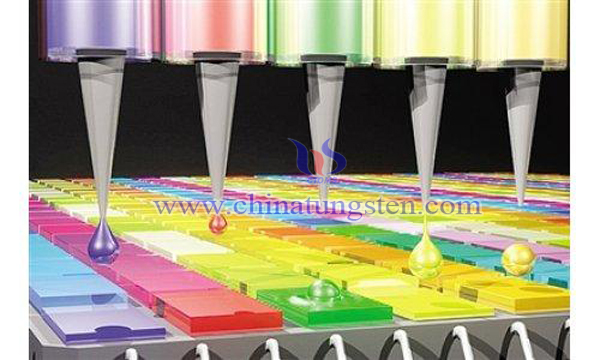Tungsten Oxide Quantum Dots Synthesis by Ultrasound Hydrothermal Method
- Details
- Category: Tungsten Information
- Published on Friday, 04 October 2019 18:20
Quantum dots (QDs) are a new kind of nano-fluorescent materials. Because of their unique electrical and optical properties, QDs have been widely used in physics, chemistry, biology and other fields. As a new fluorescent material.

Quantum dots have many advantages over traditional organic fluorescent dyes, such as wide excitation spectrum, narrow and symmetrical emission spectrum, different fluorescent colors of quantum dots with different particle sizes, simultaneous excitation of multicolor fluorescence at the same excitation wavelength, high fluorescence intensity, good stability and strong photobleaching resistance. Therefore, in recent years, quantum dots have become an ideal fluorescent probe. It is widely used in living cell marker, tissue imaging, macromolecule protein detection, Nano-biosensor and other fields.
Tungsten oxide quantum dot materials can be used for cell fluorescence imaging in medical field. Quantum dots are synthesized mainly by organic metal method. The quantum dots synthesized by this method have the advantages of monodispersity, high quantum yield and good crystallinity. However, due to the harsh reaction conditions, high cost, high toxicity and insoluble in water, the application of quantum dots is greatly limited. Therefore, the researchers used an ultrasonic hydrothermal process to prepare tungsten oxide quantum dots, including:
Weighing 0.03g tungsten sulfide (WS2) and adding 200 mL 65 ℃ secondary distilled water, the ultrasonic cleaning device (power 400 W) was used for 15 to 24 hours. The filter cake was obtained by filtration through a sand core funnel with a pore size of 0.22 um, and then the collected filter cake was suspended in 30 mL secondary distilled water. The above solution was placed in a PTFE autoclave, heated for 12 to 18 hours at 200 ℃, then cooled to room temperature to obtain hydrothermal products. Tungsten oxide quantum dot (WQD) solid powder was obtained by suspension, ethanol dispersion, centrifugation and vacuum drying (temperature 50 ~60 ℃, drying time 8 h~12 h).
Tungsten oxide quantum dot solution with a certain concentration was collocated and its fluorescence spectrum was scanned. The tungsten oxide quantum dots prepared by the above-mentioned aqueous phase were co-cultured in the aqueous system of hepatocellular carcinoma cells. The tungsten oxide quantum dots can bind to the hepatocellular carcinoma cells, enter the cells and display blue fluorescence, and the cell morphology has no significant change. It shows that the tungsten oxide quantum dots material has good biocompatibility. Its advantages are low cytotoxicity and good effect. This method is suitable for cell fluorescence imaging and labeling, gene loading, transfection and gene therapy.
- Tungsten Oxide Manufacturer & Supplier, Chinatungsten Online: www.tungsten-oxide.com
- Tungsten News & Prices of China Tungsten Industry Association: www.ctia.com.cn
- Molybdenum News & Price: news.molybdenum.com.cn
- Tel.: 86 592 5129696; Fax: 86 592 5129797; Email: sales@chinatungsten.com



 sales@chinatungsten.com
sales@chinatungsten.com